Craftsmen in big countries do not have to hand down masterpieces. A warm hand-made is worthy of time. It is for ingenuity. Report photographer Xu Zhiwei has been visiting traditional craftsmen for more than ten years, lingering in old houses and long streets and alleys in in regions south of the Yangtze River, listening to their stories and leaving their images.
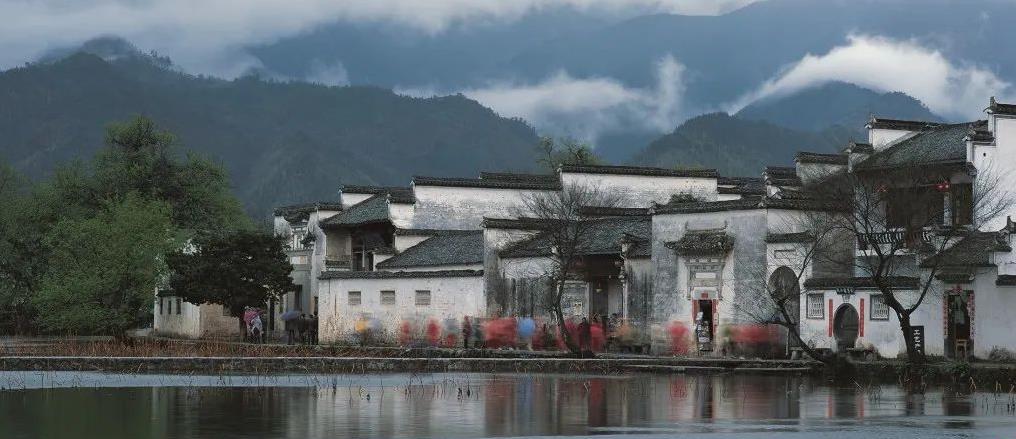
Countless codes and machines are replacing people’s hands, creating cold and repetitive things. The mainstream of the times is to pursue an efficient production model to meet the needs of a huge population, but it has almost destroyed the handicrafts we once had. It seems that we can no longer slow down and pay attention to the temperature of our hearts and hands.
For more than ten years, I have been running around the city and countryside with my camera on my back, trying to find puzzle pieces scattered about traditional Chinese crafts in various workshops and studios. The shooting plan may just come from a vague photo on the Internet, or even a rumor that cannot be verified. The reason for the endless enjoyment is very simple, my camera is facing a live-action version of “Heavenly Creation”. Through photography, I perceive the richness of the world and reveal the secrets of the unknown. Through the dialogue with the craftsman, my curiosity was satisfied, and it also gave me a feeling that cannot be described in words. I completely melted into this foreign land, observing, understanding, approaching, and then, getting the images I dreamed of as a report photographer.
The vibrant Suzhou and Yangzhou in
All things are carved out of walnuts, and Tongmu turns into zither sound
A few centuries ago, Suzhou and Yangzhou were “the first and second-class places of wealth and elegance in the world of mortals”. All kinds of elegant courtesies spread in the highly developed material civilization in the south of the Yangtze River. Among them, scholars of the scholar family talked about the beautiful nature with relish, pursuing a high degree of artistry and refinement of life details. They personally participated in the design of gardens, water stones, furniture, and entertainment, and were fascinated by the delicacy and significance of elegant objects with sleeves. A small thing outside the body can give you considerable charm and talent. Among them, it includes the walnut carvings that record the myriad changes of heaven and earth within a square inch.

As a traditional handicraft with distinctive regional characteristics, walnut carving is also known as “Suzhou walnut carving”. In Suzhou, this skill of making delicate playthings with worthless small objects such as olive stones and even peach stones has been persistently inherited and continued.
I have traveled through the countryside of Suzhou to witness the restoration of local traditional scenery: there are more and more water alleys and stone bridges near the Library Town, and there are more and more small courtyards with white walls and black tiles, which is very old Suzhou. Zhaohuaxin’s walnut carving studio was hidden in these courtyards. When I walked in, he was selecting the walnut. A sack of olive cores was poured into the bamboo plaque. When it was fully dried, it became even more ashen, and even raised a burst of dust.
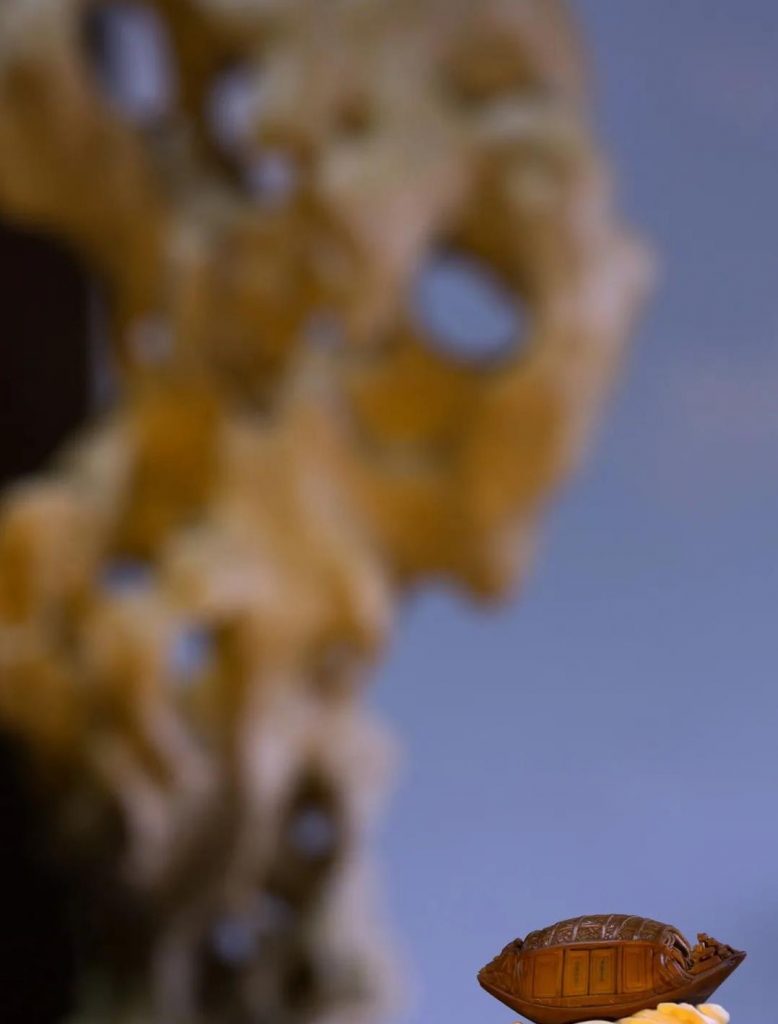
A full, smooth and ruddy core with a maximum diameter of more than 2.2 cm and a length of about 4.5 cm is the heart of the walnut carving masters. Master Zhao picked up one and looked at it carefully in his hand. “There is no such good material in a hundred miles.” He said with a smile. The olive stone used for walnut carving is hard won. Among the 100 kg of stone picked from an olive tree, only 1-2 kg of good material can be selected. It must be naturally dried in a dark and ventilated place for twoorthree years before it can be placed on the workbench of the walnut carving master.
Master Zhao’s carving table is nothing but an old desk with red paint, a cane chair and dozens of knives. It is basically all he needs. In front of the camera, a piece of wood was firmly nailed to the table, full of knife marks, obviously used for a long time. As a traditional handicraft, these tools are not cumbersome, and some are even made by the masters themselves according to their usage habits. It is such a carving knife that carves rough olive cores into exquisite works of art.

I have the honor to record the birth of walnut carving works. The skills under the lens are nothing more than carving, carving, drilling, cutting, cutting, punching and stripping. A few small carved knives forged from fine steel, such as the pen in the painter’s hand, are one for stripping, the other for adding, wandering around, not according to common sense, and there is no set pattern. Dropping the knife cannot be wrong, just like playing chess without regret and irreversibility… A work was born from this.
It is an interesting thing to appreciate the walnut Carvings: when placed on the red sandalwood shelf, the warm tone of the setting sun gives it a thick coating. When you appreciate it carefully, you can see the ancient pines are powerful, the painting pavilion has natural wings, the river in the distance is wide, the sand gulls are abundant, and the mountains are verdant. There is a coir hat Weng walking on a short bridge with a stick, and wandering about to climb a boat in the river… The painting of the Song Dynasty leaps forward.
Who remembers the primitive appearance of this walnut when you rub it through the rain covered window at night?
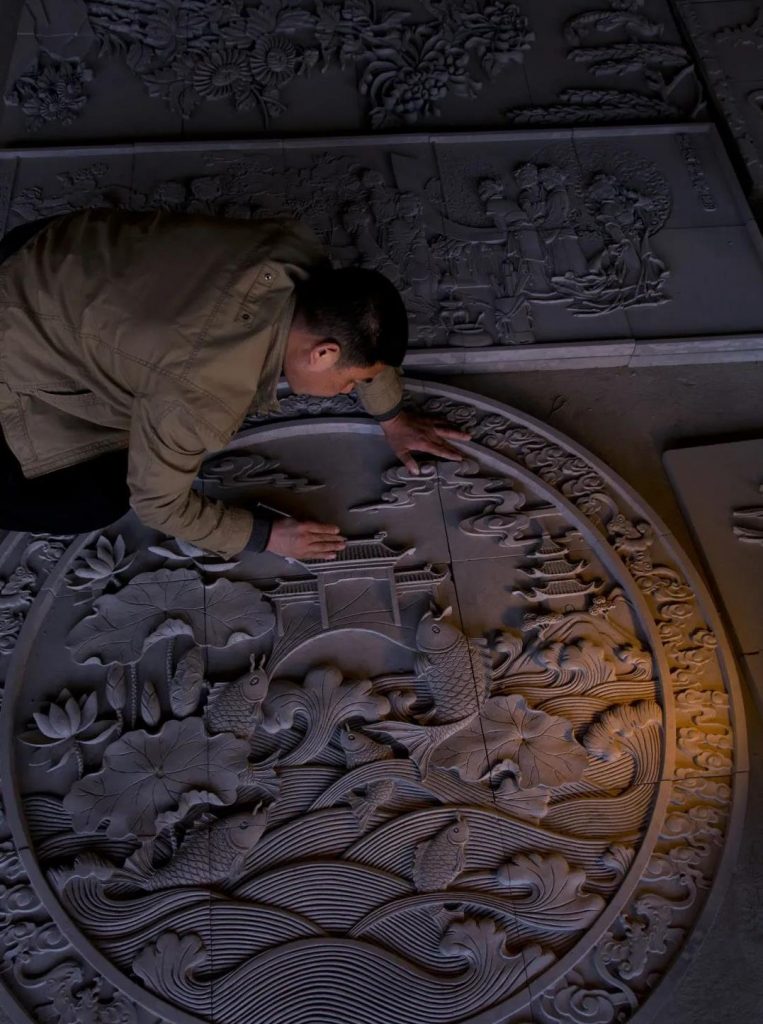
Yangzhou has the delicacy of the south of the Yangtze River, and the old houses in the alleys should not be underestimated. The green willow deep lane, with people leaning on the Zhumen, is mostly an old-fashioned garden that can be visited and lived. The cultural and material environment is so exquisite. Naturally, there should be a scene of “silk and bamboo melodious and orchestral diseases” in such a garden. The Qin has never been separated from the cultural context of the city.
Following the charm of Yangzhou, I turned into an old house in Dongguan old street. In the corner of the house, there were plantains listening to the rain in summer and plum trees making tea in winter. Raofeng, a zither player, created an ancient zither world in the house.
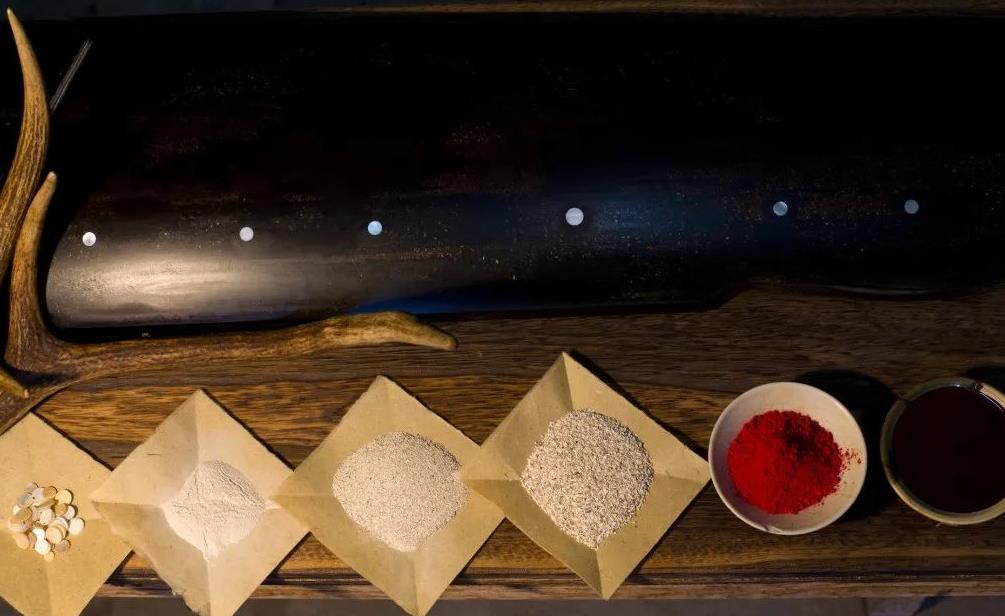
“Zhuo Qin” is a unique zither making technique in Yangzhou. The word “Zhuo” is simple and exquisite. The word “Zhuo” has an ancient meaning. The sound is the same as “Zhuo”, which means cutting. Why use this archaic verb? Before the great boycott of the Qin, you need to chop the wood with a big axe. The word “Qin” evolved from the “music” of music. In oracle bone inscriptions, the word “music” has “silk” and “wood”, which means “the silk is stretched on the wood for the Qin”. The word “Qin” evolved in the period of the seal script.
There are countless attentions to “wood” when playing zither. Experienced pianists believe that the panel of an ancient Qin should be softer and the bottom plate should be harder. Because the piano surface is intended to be the sky, and the sky is gathered by Yang Qi, it is often made of loose Tung wood and fir; The bottom of the piano is intended to be the ground, which is the collection of Yin Qi. Solid catalpa and nanmu are mostly used. “For a zither player, this may be a matter of personal preference. Many masters like fir, because although it is easy to vibrate, it is not as delicate as fir.” Rao Feng said.
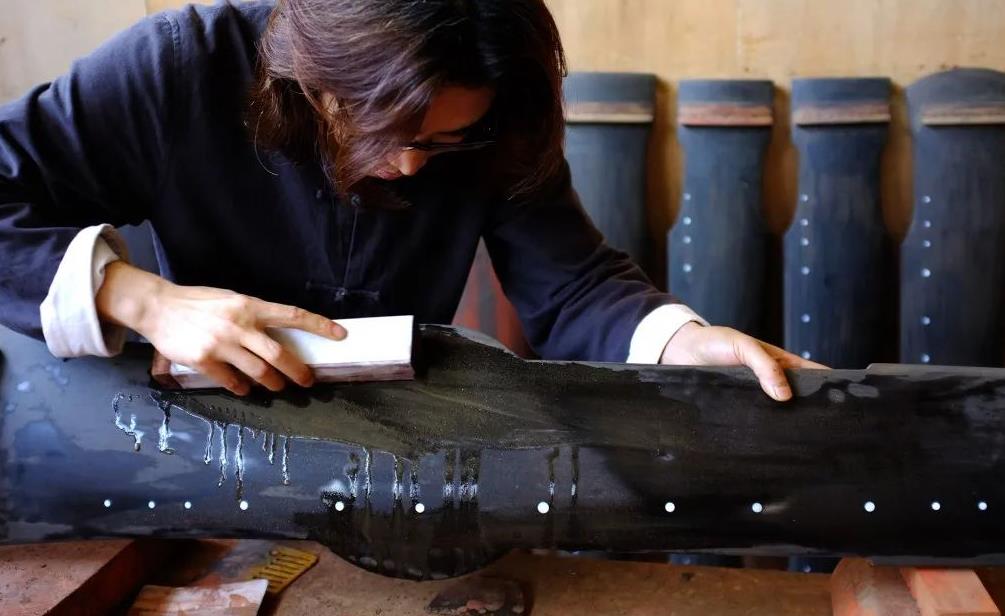
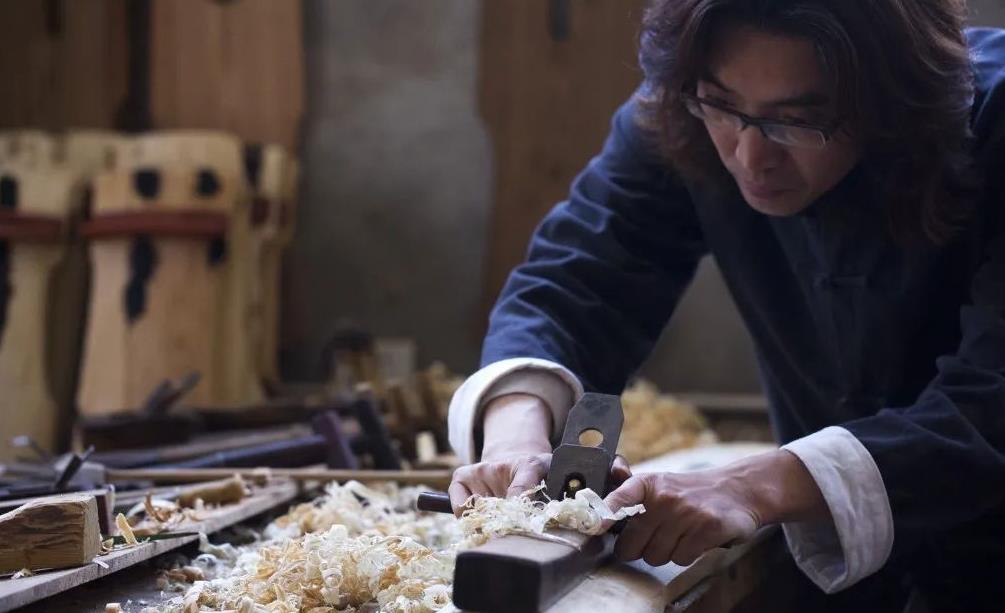
In my lens, Rao Feng simply sketched out the lines of the ancient Qin on the Tung wood board, and dug out the cavity after the embryo… In the design concept of the ancient Qin, there are mountains, water, and a high degree of harmony between man and nature. Rao Feng was solemn when he played the lute. I merged the classical window of Jiangnan charm with his side face into the mirror. Chinese literati have an understanding and reverence for nature, and so do craftsmen.
It is worth mentioning that the lacquer used for Guqin must be used together with antler cream. Antler cream is the antlers of sika deer. “There are allusions and reasons for choosing antlers.” Rao Feng said, “the ancients believed that the sound of deer singing was melodious and smooth. It was used on the ancient Qin and had a great charm. This thing has a moderate density and is suitable for softness. In particular, it also has small hollow particles, which can fully absorb the lacquer and make the Qin.” He poured the finest antler cream into the sieve basket and shook it gently. Under the goose yellow light, the antler cream was scattered on the paved rice paper, like frost and snow.
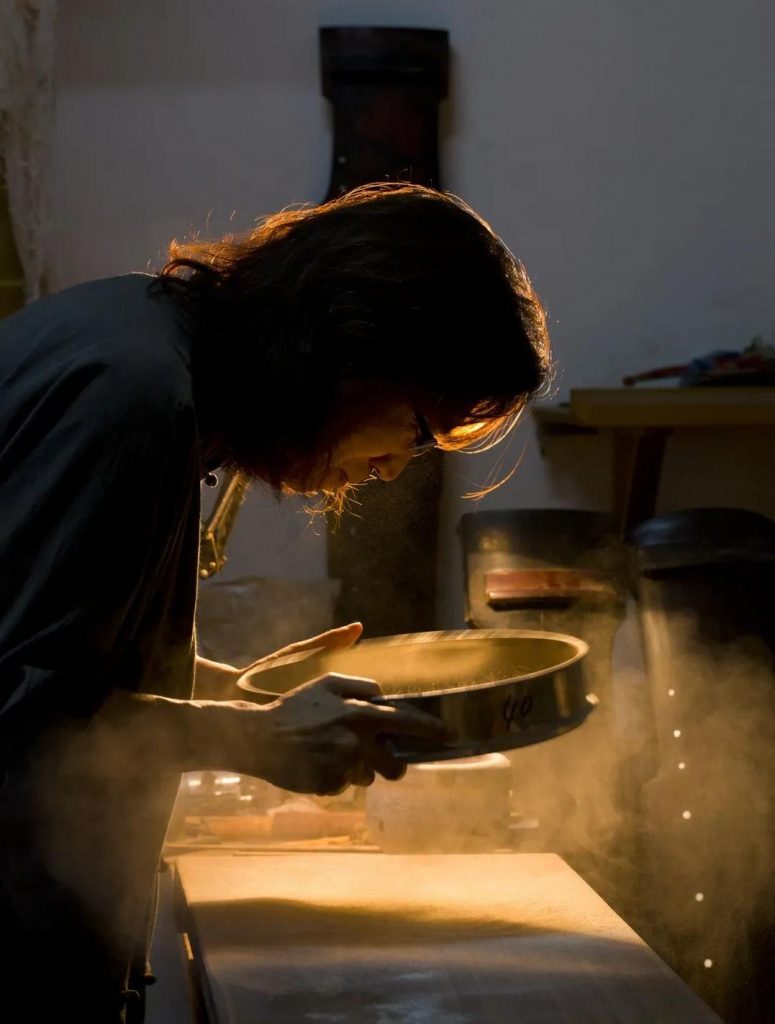
Xiuning in Huizhou style
The worldly dried tofu and dumplings
In many cases, cameras are aggressive objects. Even for the reporting task of the key topics of the first-line magazines, I will not wear the tawny vest with hundreds of pockets sewn, which will remind my subjects: “Oh, there is a photographer over there.” The camera will get some faces full of doubts and even hostility.
Therefore, equipped with a Canvas Backpack, khaki pants, lattice shirt, interchangeable lens side axis camera, and a kind smile, you will look more like a tourist. You can easily sneak into the ancient alley, the old workshop, the chess stall near the gate, the kitchen in the mutton soup shop, and the residents’ old homes… If you really “melt” in a foreign land, you can experience a bowl of wonton and a bowl of dumplings, Or human fireworks in a piece of dried tofu.
In addition to capturing the charm of Jiangnan in Jiangsu, I often visit Anhui to find Huizhou scenery in the streets and lanes. In 2014, I set foot on Wan’an old street in Xiuning County and recorded the story of a tofu workshop and its owner.
This tofu shop has been open for more than 100 years. As early as the 11th year of Xianfeng, Du Yannian’s ancestors set up a tofu workshop here, with constant fireworks and crafts. When duyannian graduated from junior high school, his father died, so he had to drop out of school to take over the tofu workshop inherited by his ancestors. It has been 76 years. Now he is 94 years old. Apart from the electric lights and bean grinders gradually added to the houses where they live, the rest are no different from those more than a century ago.
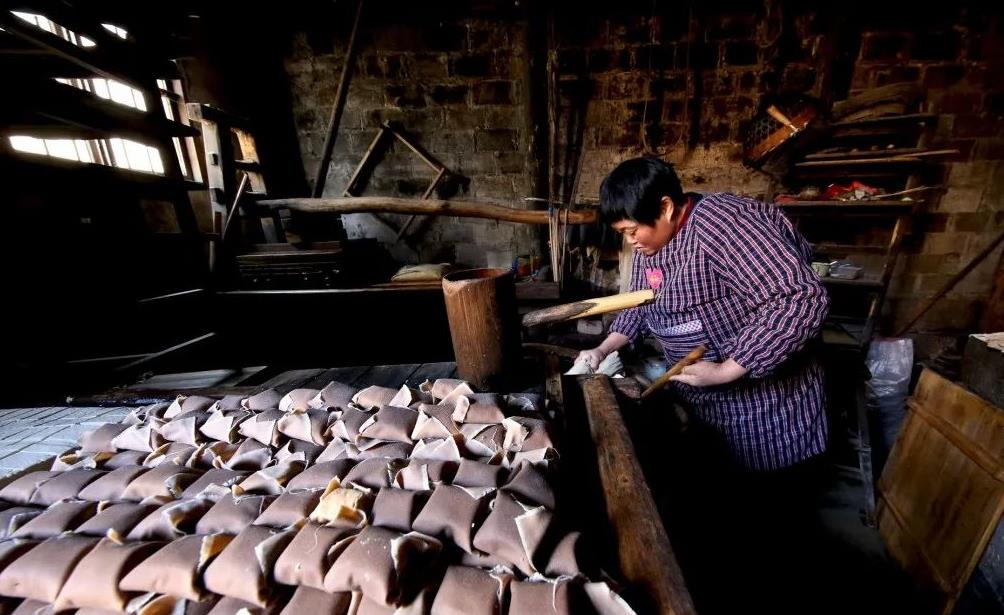
The workshop produces authentic Huizhou dried beans, which are handmade. After a plate of tofu is prepared, cut it into four centimeter square pieces with a knife, wrap it with cotton cloth, and then put it back on the board. When the five or six boards are made, you can press the tofu to dry. The wood press used in the workshop is thick and heavy. It is operated by dushuwen, the daughter of the workshop owner who passed the year of Huajia. I saw her carefully put the wrapped tofu board in place, then insert a huge wooden bar into the slot, tie hemp rope, and press stones. The water and pores in the tofu are squeezed out little by little through leverage. At this time, the air is free of bean fragrance and echoes with the subtle creak of wood
After waiting with them for half an hour, I saw that the white tofu changed from trembling to thin, cotton textured dried tofu… The stewed dried tofu was neatly stacked on the bamboo plaque, as if Du Yannian, an old man, was sitting next to them. I took their group photos.
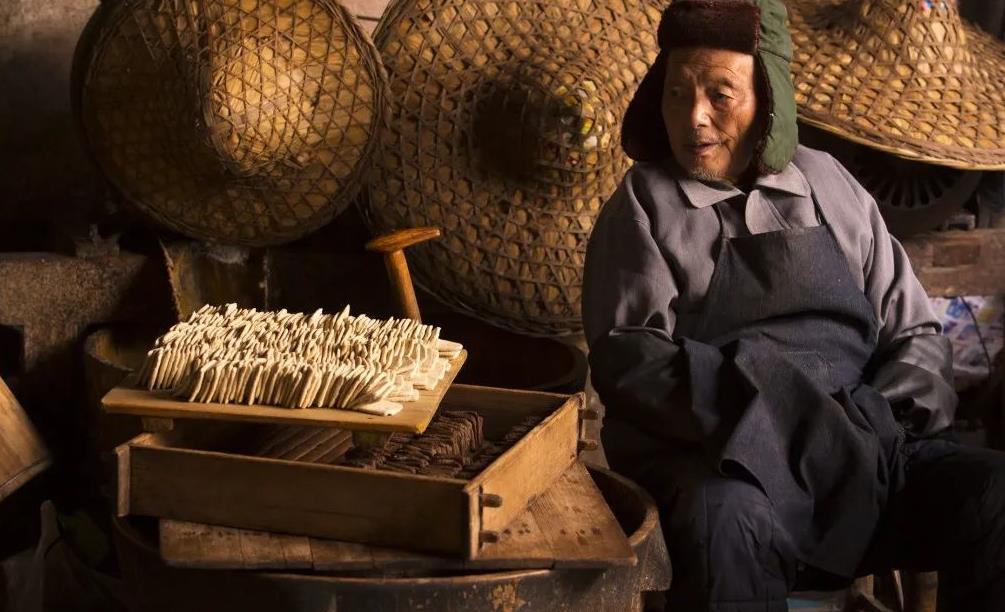
Take a bite of this hand-made dried tofu, which is firm and elastic, flexible and fragrant. It is completely different from the mass market goods produced by machines. At this time, the neighbor came in, and the old man did not raise his head: “how much?” “Half of 500g. Here’s the money. Let’s go.” I listened to the lines, but I felt that I didn’t owe business or friendship.
Year after year, except for three days’ rest during the new year, the Du family has been doing tofu, dried tofu, hairy tofu and tofu skin, and their skills have been praised by the neighbors. But every day from three o’clock in the morning, I can only make seven or eight kilograms of dried tofu a day. One kilogram of dried tofu sells for only ten yuan. The low income and craftsman spirit together have supported this ancient craft, so that the traditional Chinese flavor can be inherited.
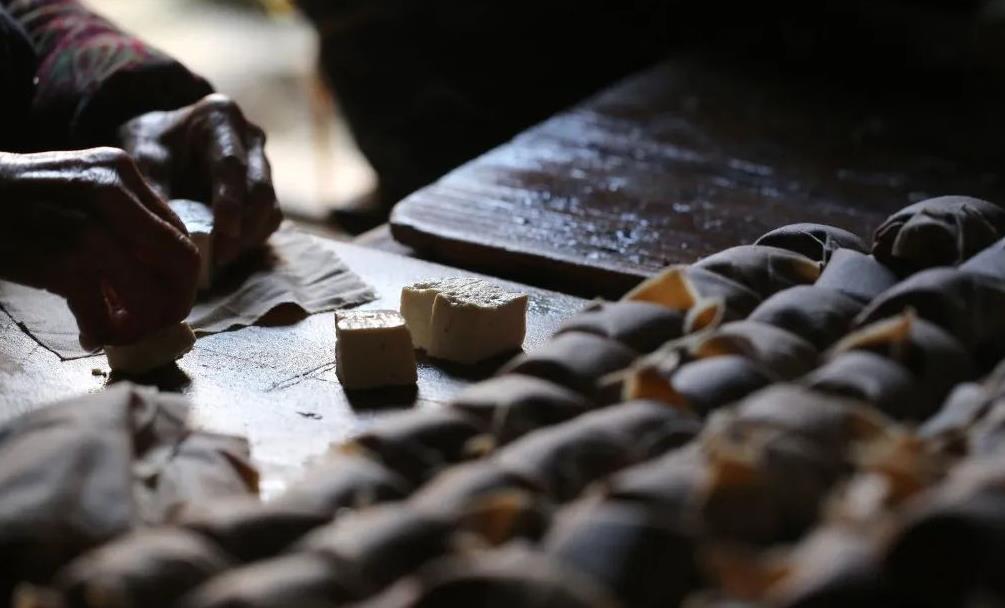
Rural snacks often hide a simple warmth. They are the most inconspicuous but the most pressing. In addition to handmade dried tofu, Xiuning also has “dumplings”. There is a peilang River in Xiuning County, passing through Yu village, the hometown of wangshishen, a painter in the Qing Dynasty. Here, a bowl of hot Huizhou traditional dumplings is also more exquisite.
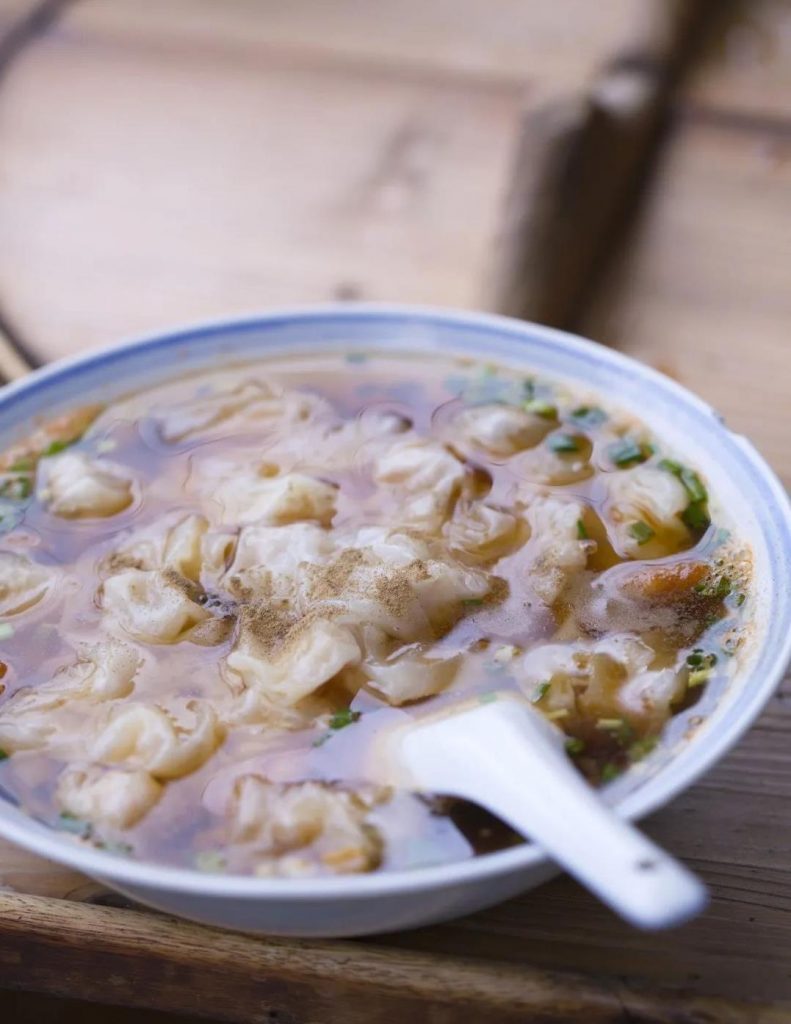
Dumplings are small wonton, which Huizhou calls “dim sum”. I have photographed the process of making dumplings, rolling out the skin, cutting the stuffing, and putting them into the pot… Just a few pictures are enough to make people salivate. Its leather is rolled by hand. From flour to dumpling making leather, it needs to keep rolling for more than two and a half hours: the leather is spread on the board, wrapped on the rolling pin, and gradually stretched thin and transparent in a pair of hands covered with flour. And the scene of putting into and out of the pot was full of heat and aroma, which became the climax of the performance.

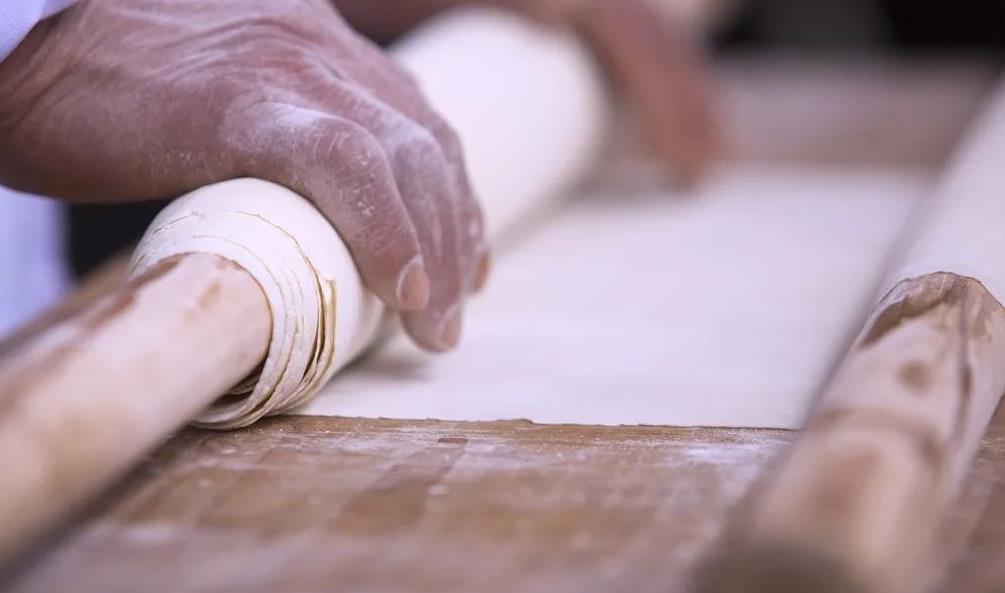
In the alley, an old copper pot was divided into two parts, half boiling water and half boiling dumplings. The firewood under the pot was booming and crackling. The dumplings on the pot were driven off the board and rolled into the water. When they were picked up, they were as good as jade. In the big bowl with the blue edge, small pieces of lard, fine scallions, broken oil residue and pickled mustard have been served for a long time. After dumplings are made into the bowl, they are not finished. The black pepper in the bamboo tube is gently sprinkled into the soup, and then there is a soul.
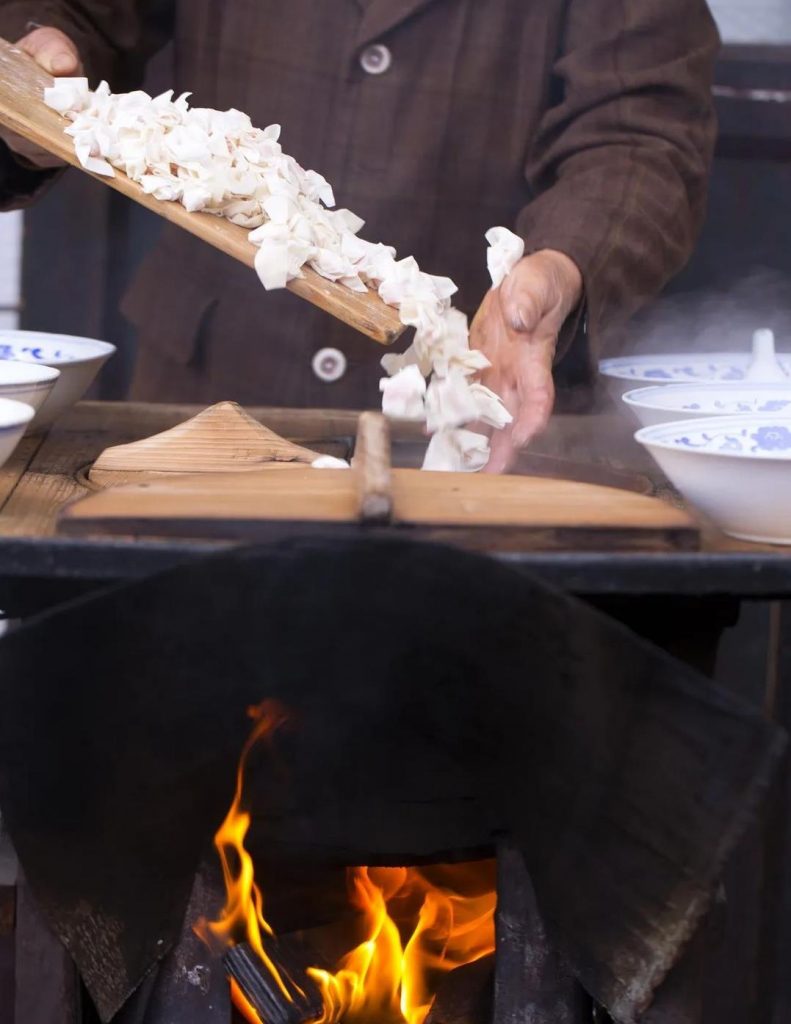
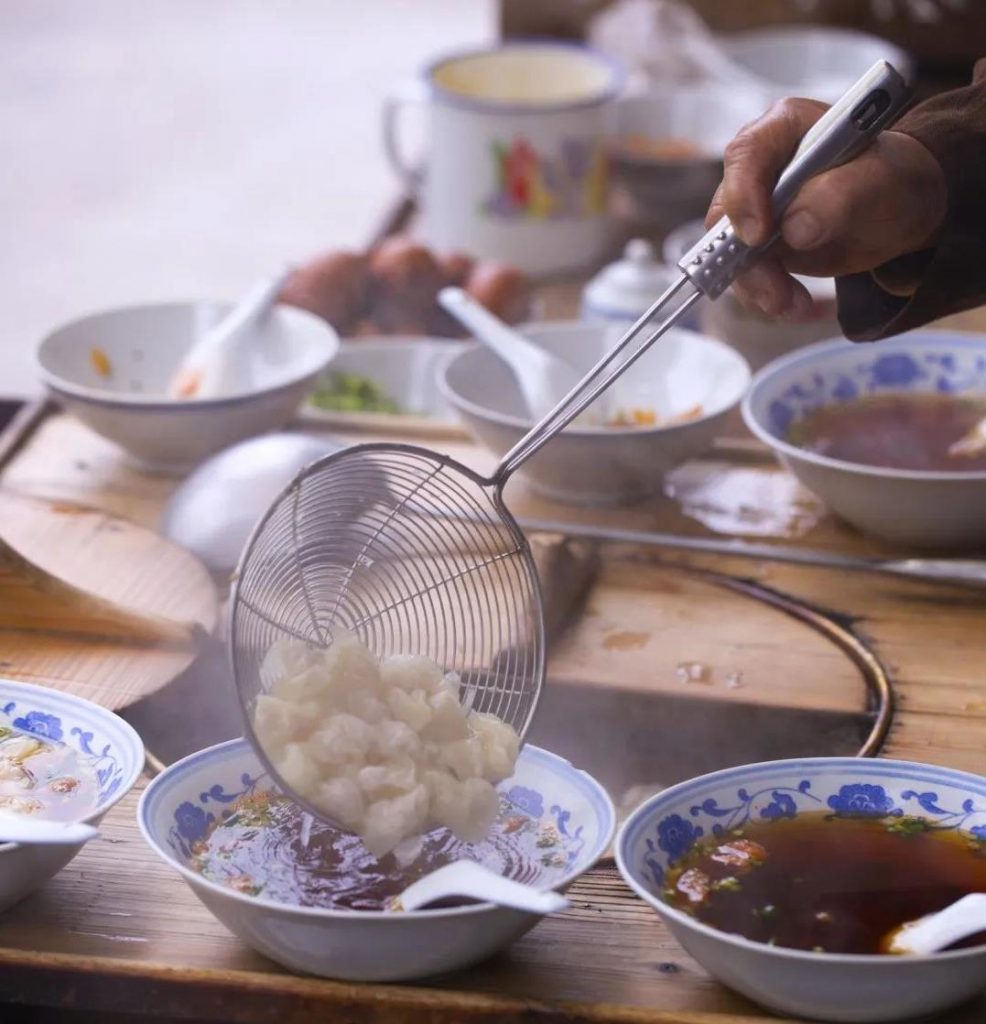
A village called Gufeng
You can also find the oilcloth umbrella borrowed by White Snake
After many years of long and short alleys, I deeply feel that elegance and wit can be tasted from the trivialities of life. In the south of the Yangtze River, it is most suitable to use traditional household items such as oil cloth umbrellas. Just imagine how bluestone, Xuanyi, and Yuxiang can accommodate chrome, chemical fiber, and plastic? A small oilcloth umbrella, made of bamboo, cotton cloth and tung oil, is simple and elegant, and can be described as one of the highest aesthetic realms in Chinese tradition. A “Legend of the White Snake” has moved the Chinese people for hundreds of years. When they met at the broken bridge, the tarpaulin umbrella borrowed from Xu Xian in Bai She’s hand expressed the feelings and sighs of many people.
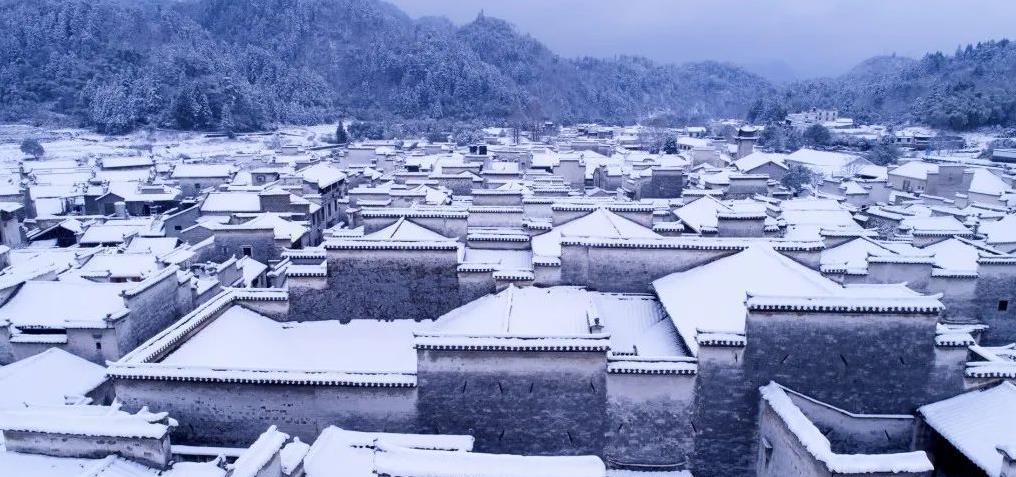
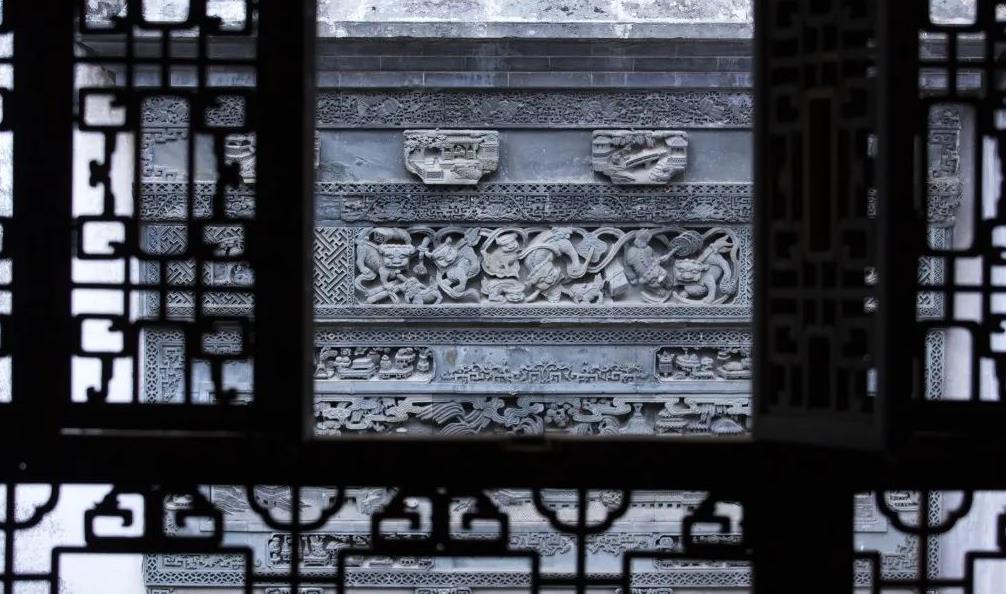
Zheng Guomin from Gufeng Village, Jing County, Anhui Province, has been dealing with umbrellas all his life. This is not only his business, but also a skill handed down from his ancestors. He said that since the Qianlong period, the Zheng family has been in the business of tarpaulin umbrellas. Their family uses the craftsmanship inherited from their ancestors to source materials locally to make tarpaulin umbrellas for people. “Even now, people in the countryside still like the umbrellas made by my family. They are large in size, strong and durable, and they also protect against lightning!” Zheng Guomin’s face was filled with pride.
With the trend of the times, the folding umbrella made by the assembly line still squeezes the ancient oilcloth umbrella into the corner. Once, in its heyday, there were more than 1,000 people in Gufeng Village, Jingxian County, who were engaged in the production of traditional oilcloth umbrellas, and there were many umbrella shops in the market. Today, Zheng Guomin’s workshop is the surviving tarpaulin umbrella workshop with a certain production capacity and adhering to traditional craftsmanship in the south of the Yangtze River. Today, the “employees” of this traditional workshop are almost all elderly people, and the youngest are around 60 years old.
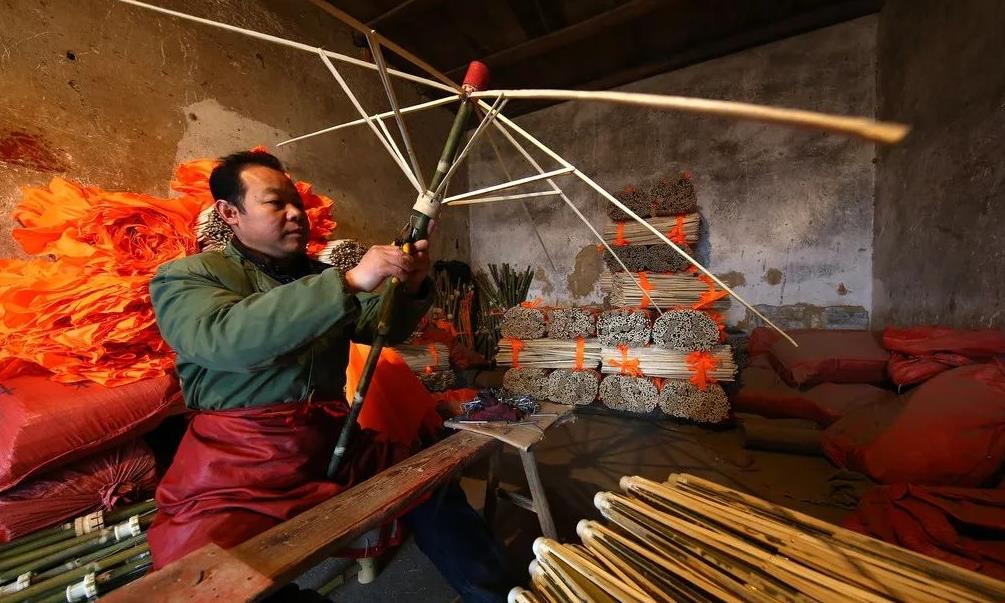

An oil cloth umbrella that is completely completed in accordance with the ancient system needs to go through the main processes of making the umbrella rib, umbrella reed plate, umbrella handle, umbrella cover, umbrella stand, and installing the umbrella cover and oil umbrella. There are more than a dozen small processes such as slicing, punching, bamboo rowing, drying, etc., and only simple tools such as hammers, files, measuring rulers, scissors, drills, etc., can take a week to complete.
When photographing tarpaulin umbrellas, it’s hard not to be drawn to the vibrant colors. Whether they are densely packed in the house, or placed in the yard to dry in a flamboyant manner, the picture taken is a bright orange-yellow-in a building dominated by gray tones, it is rendered. The most seductive Jiangnan style.
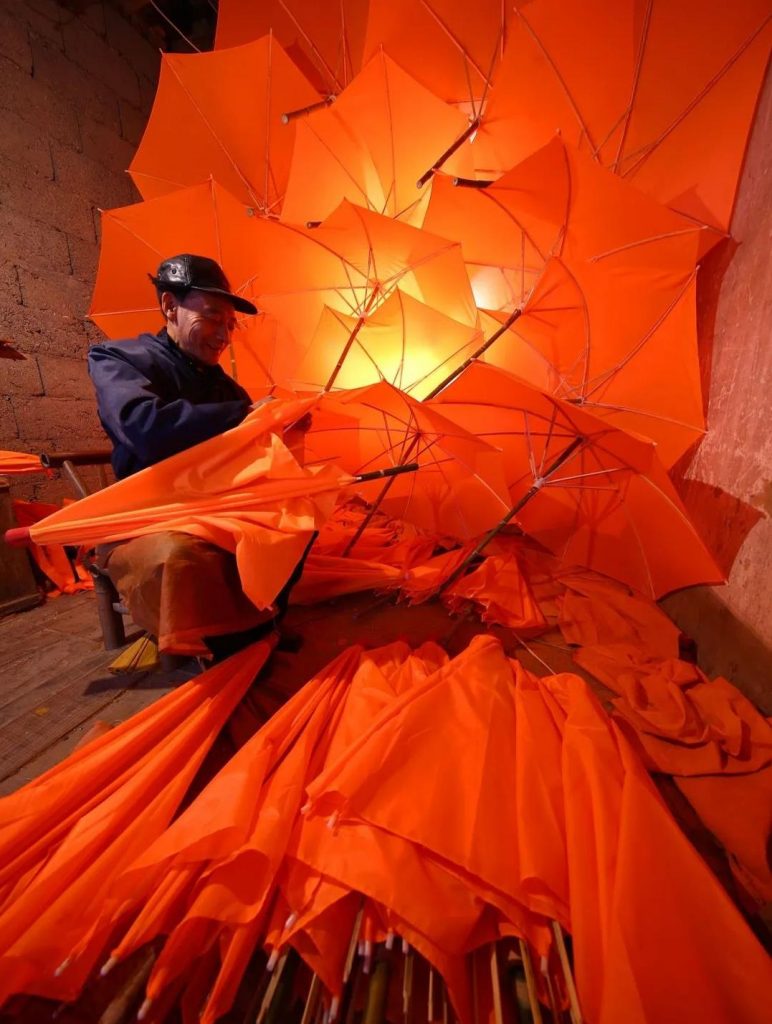

Every time I shoot an old craft, I have to go through untold hardships to get out of modern life and go to a completely different space. Time and time again, I have “transported” myself to a certain time and space. There are no soft mattresses in these places, the network signal is an extravagant hope, the local language is sometimes like a book from heaven, and even the food is difficult to swallow… It can be said that these unfamiliar The scenery and my world seem to have no intersection at all.
But maybe that’s why I’m so curious about it all. I picked up the camera again and again and went to one old-fashioned workshop after another. They were like space-time capsules one after another. They didn’t intend to keep up with the trend of modernization, and stubbornly maintained the appearance of decades and hundreds of years ago. Yes, I am the recorder of old craftsmanship and the listener of every story. Now, let these images replace them and me, and let them speak.
Comments